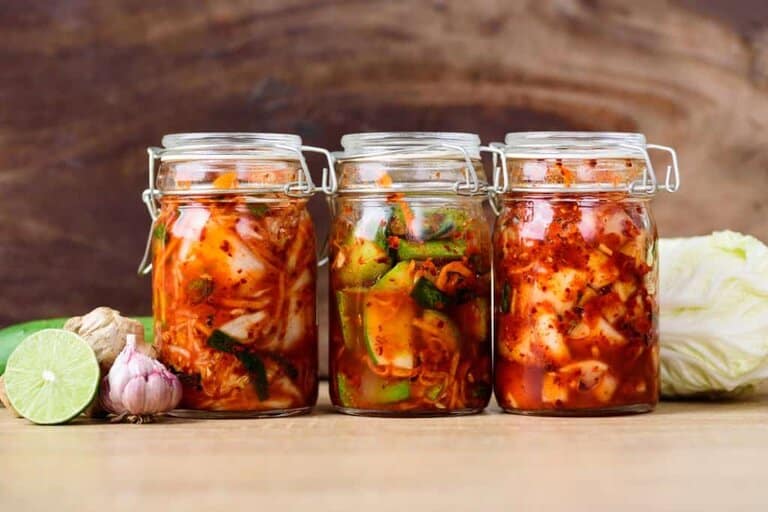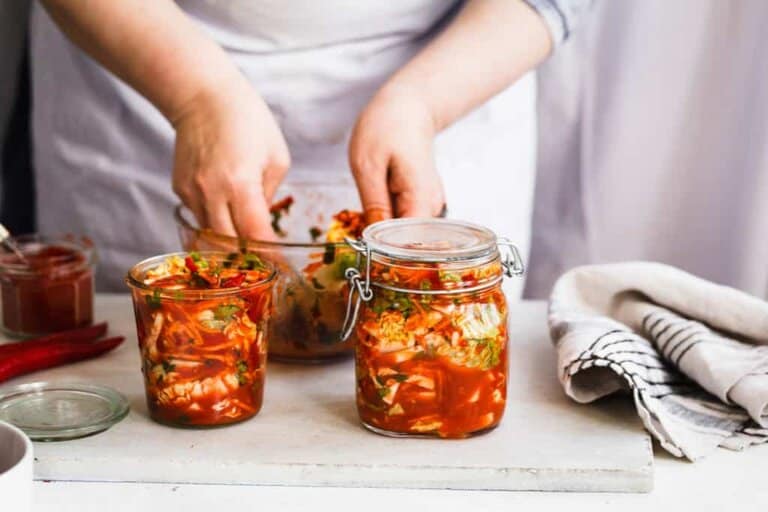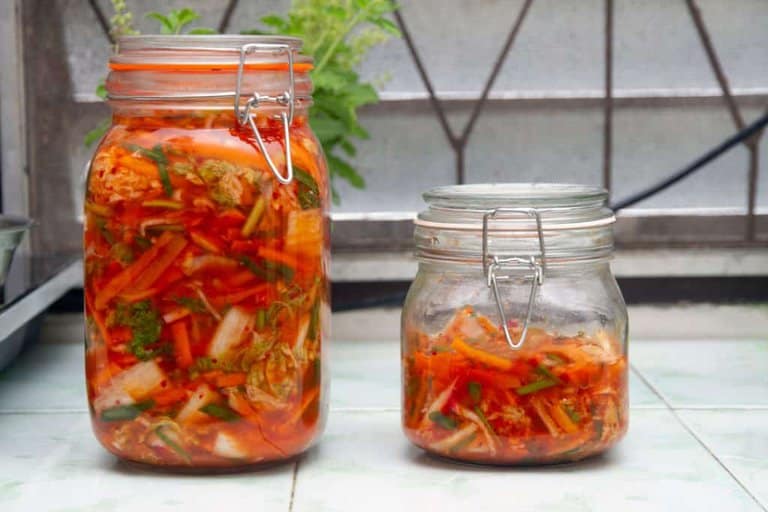You can definitely freeze kimchi. This delicious and healthy mix of flavors and veggies will last in the freezer for around three months without changing its taste or texture.
From the first time I tasted Kimchi, I’ve introduced the famous Korean dish to everybody who cares to try it. In my opinion, everyone deserves a taste of this exceptional cuisine.
However, loving kimchi that much comes with learning the best methods to preserve what is left after eating.

So, I have tried freezing kimchi, and I was surprised to realize that compared to other preservation methods, freezing doesn’t change the texture, taste, or flavor at all. This gives you the confidence to make a lot of delicious kimchi without worrying about it getting spoiled.
In this article, I’ll explain how I freeze kimchi and share with you my top alternatives for storing kimchi properly so you can enjoy it for up to 3 months.
How To Properly Freeze Kimchi
Kimchi can actually last for about 3-6 days without any preservation. Its organic ingredients allow it to preserve itself for that long. However, freezing kimchi can make it last even longer.
These steps below will guide you on how to freeze kimchi properly.
Step 1: Get An Airtight Container
- You need to use an airtight container to keep the kimchi fresh for a long time. Avoid using containers or bags that allow air to pass through them. This exposure would make the Kimchi ferment too fast and cause spoilage.
- If you want to make a lot of kimchi, invest in vacuum sealers. This will make it much easier to store larger quantities. Vacuum bags are widely available in most supermarkets.
- Another alternative is a ziplock freezer bag. However, if your kimchi isn’t homemade, you wouldn’t need these options. It is okay to also put the Kimchi back in the container you bought it in.

Step 2: Pour The Kimchi into The Container or Bag
- Simply transfer your Kimchi into your storage vessel.
- Ensure you separate your kimchi into smaller quantities if you intend to freeze a lot. This ensures there’s enough space for the kimchi to expand in the container while freezing.
Step 3: Label The Container And Put It Into The Freezer
- Kimchi is no longer safe to eat if frozen beyond 3 months, depending on the quantity and ingredients used. By labeling your container, you can keep track of how long it has been frozen and avoid food poisoning.
Quick Tip: Opening and closing the container continuously will cause the Kimchi to spoil faster. So, separate your Kimchi into smaller portions you can eat at a go.
Benefits Of Freezing Kimchi
Freezing kimchi is a popular Korean tradition, and here are reasons you should also freeze your kimchi for later consumption.
Extend Shelf Life
If you don’t try to preserve your kimchi after opening it, it will go bad after about 5 days at room temperature. Freezing your Kimchi helps extend the shelf life up to three months.
Organic Texture
Freezing vegetables usually cause a change in texture when you defrost them. However, Kimchi doesn’t have as much moisture as most vegetables. So, when you defrost, the texture remains intact even after thawing.
Easy Storage
Freezing kimchi is one of the easiest ways to store it. You just need to follow the simple guidelines I mentioned earlier and freeze under the right circumstances.
How To Defrost Kimchi
If you freeze your kimchi, you’ll need to thaw it out before using it again to preserve the texture, flavor, and taste. Here are three methods to choose from depending on your preference.
Use A Refrigerator
Defrosting Kimchi is pretty simple and effective when you use a refrigerator. This method works well with any type of Kimchi and ensures that your Kimchi doesn’t lose its flavor during the defrosting process,
To get started
- Simply take it out of the freezer and place it inside the fridge. Ensure to leave the kimchi in its container while doing that. However, you should put the container on a plate to avoid water leaking into your fridge.
- You can regulate the fridge temperature to be a bit higher. This will help your Kimchi to defrost faster.
- After a few hours, check to see if it thawed to your expectation and use it immediately to enjoy its best flavor.
Keep At Room Temperature
This method involves leaving the Kimchi to defrost slowly over several hours.

- Take it out of the freezer, remove the lid and place it somewhere warm like your kitchen counter or dining table.
- If you’re not sure where to put it, just make sure it’s not somewhere exposed to direct sunlight. Sunlight disrupts the proper thawing process and can make your kimchi soggy.
- Leave the Kimchi for about 4 hours, and then check to see if it’s defrosted enough to use.
Warm With A Microwave
This works well because microwaves penetrate food quickly, making them ideal for heating and defrosting foods.
- Simply place the Kimchi in the microwave for 30 seconds. Ensure you cover the container with plastic wrap or foil first so that any steam does not escape.
- Microwaving kimchi for too long isn’t recommended because it may cause the kimchi to lose its flavor.
- After microwaving, let the Kimchi sit for another 10-15 minutes until completely defrosted.
- Use immediately after it is thawed.
How To Tell If Frozen Kimchi Is Bad?
Kimchi has a longer shelf life than most vegetables, so the texture should remain firm and solid even after being frozen. However, if it has been frozen for more than three months or exposed to air and moisture, there’s a high probability that your kimchi is no longer fresh.

Here are signs that your kimchi might be spoiled:
Taste
Kimchi is a fermented food that contains a lot of probiotics. Unfortunately, this probiotic bacteria can create a bad taste in your mouth if the kimchi is too old or has been stored at a high temperature. If you feel a strong or sour taste in your mouth, this means that your kimchi is bad.
Quick Tip: If your Kimchi tastes sour but smells right,.It is okay to prepare it with soup and stew.
Color
The color of your kimchi should be vibrant and bright yellow or red. If it appears dull and pale, your kimchi is old and needs to be thrown away.
Texture
Kimchi’s best days are ahead of it, so don’t be worried if it’s a little soft when it’s freshly made. But if it feels mushy, throw it away. A good rule of thumb is to use kimchi within one week of opening the jar.
Smell
The smell of fermentation is normal, but it should dissipate completely once your kimchi has been refrigerated. If you notice an odor that seems abnormal, like a really sour or moldy smell that just doesn’t go away, your kimchi is likely bad.
Any Visible Mold Growth
Mold on your kimchi can mean that the kimchi was stored incorrectly and has been contaminated by bacteria during storage. Don’t try to segregate the contaminated veggies and the untouched ones. You still stand a risk of food poisoning if you do.
Alternative Ways Of Preserving Kimchi
Freezing kimchi is the best way to extend its shelf life, but there are some other tricks you can also use to preserve it. Here are some great alternatives to freezing kimchi that will increase its shelf life.

Dehydration
Moisture allows bacteria and other microorganisms that can spoil food to thrive. So, a great way to preserve Kimchi is to dry it using a food dehydrator.
To get started
- Dice your kimchi into smaller sizes to reduce the moisture concentration level.
- Then, use a fork to spread the kimchi on the food dehydrator.
- Turn your food dehydrator to full blast at 145 degrees Fahrenheit and dry for 10-12 hours.
- Once it is dry, store it in an airtight container and then place is a cool and dark place; this will help it last for 3-5 months.
Canning
You don’t have to put your kimchi in a can to preserve it, but it’s a great option if you make large batches and want to save fridge space.
To get started
- Add a little amount of vinegar to the jar to help with the pickling and preservation.
- Next, fill the jars with your kimchi and then top them off with water. Make sure to leave about 1/8 inch headspace from the top of the jar.
- Place a lid tightly on the jar and then process in a pressure cooker (or boil in a deep pan on a stove) for 15 minutes.
- Once done, remove the jars from heat and allow them to sit for 5 minutes before removing the lids.
- Store in a cool and dark place, and they will stay fresh for at least 3 weeks.
FAQs On Can I Freeze Kimchi
Can You Refreeze Kimchi?
You should not refreeze kimchi because it can cause it to lose its flavor and crispness and grow mold. To avoid refreezing, you should always freeze and defrost your kimchi in smaller portions that you can use at a go.
Why Does Kimchi Overflow?
When you open a container of kimchi for the first time, you may notice it pop and overflow. This is due to fermentation, and it’s perfectly normal and nothing to worry about. So, the next time you open a new container of kimchi, open it over the sink just in case it starts to bubble.